3.1.1 Purse Nets
3.1.1.1 Types and Description
The principle of this gear is to pull fish from the water by moving a net which acts in the water like a filter. In African fresh waters, such nets are always used after attracting fish by means of small lamp-carrying boats which concentrate the fish on the surface. Three main types of purse nets are employed:
purse seines operated by one boat;
purse seines operated by two boats, and
surrounding nets or chiromila with a purseline.
Only the purse seines operated by one boat are dealt with below because they are easy to manufacture and use and because they require a relatively small initial investment. These seines are more effective than the other purse nets. They effectively surround the schools of fish which cannot escape under them.
This type of fishing is carried on in Tanzania on Lake Tanganyika, involving a wooden boat 9 to 20 m long, an auxiliary 5 m long boat and three lamp-carrying boats. All of them are built locally. The seine, 176 m with a drop of 53 m, catches mainly small pelagic clupeids and their predators (Figs.1, 2 and 3).

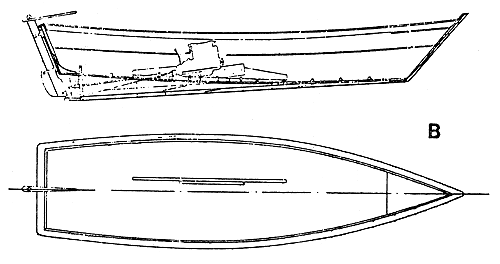
Fig. 1 Lake Tanganyika water taxi (A), modified for artisanal purse seines (B).

Fig. 2 Lamp boat for artisanal purse seine fishing, general arrangement
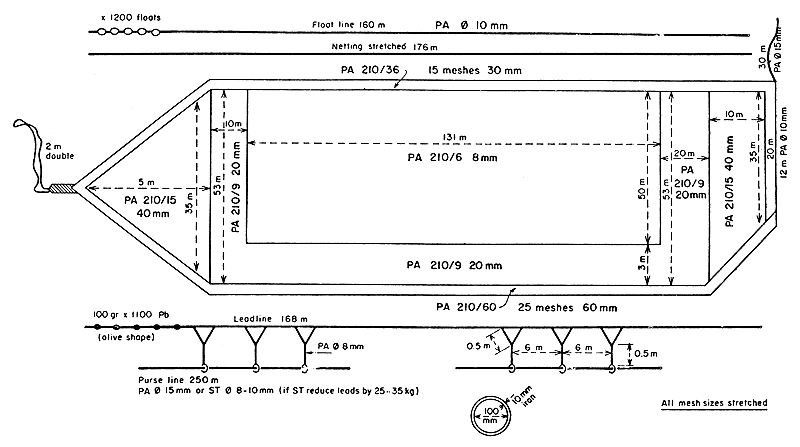
Fig. 3 Artisanal purse seine used on Lake Tanganyika
3.1.1.2 Ease of Handling
This material is relatively simple to handle and can be operated by villagers without special training. This kind of fishing can be easily practised in pelagic areas far from the shore, without danger to the boat or the crew.
3.1.1.3 Manpower
Abundant manpower (16 men) is necessary for this kind of fishing. It calls for a master fisherman assisted by three fishermen with a minimum of experience. Another 12 crew members are needed to lift the seine by hand because no mechanical or hydraulic winches are employed.
3.1.1.4 Initial Investment and Operating Costs (Tanzania, December 1976)
| U.S.$ | |
| Main boat | 8 850 |
| Engine for main boat | 5 300 |
| Auxiliary boat, lamp-carrying boats and lamps | 4 750 |
| Purse seine | 11 750 |
| Miscellaneous | 1 175 |
| 31 825 |
For proper operation of such a unit, U.S.$ 60 have to be budgeted per night (1976–77).
The investment costs are less than U.S.$ 50 000, and the Ujamaa cooperative villages on the lake can obtain a loan which is granted to rural villages. The fact that the fishermen's wages account for more than 50 percent of operating costs is the foremost factor for choosing this fishing method. It provides the villages with money which is beneficial for development policy in the whole region.
3.1.1.5 Local Manufacture and Supply of Material
All material for boats and nets is made in the country. The boats are built of Tanzanian timber and all the material for the nets is bought locally; the same applies to the lead weights which come from old batteries.
3.1.1.6 Upkeep, Repair and Durability
Upkeep and repair of small material involves above all the replacement of the mantles and glass of the pressure lamps (8.7 percent of operating costs, or U.S.$ 238 a year). The net, to ensure that it lasts five years, must be regularly mended at a cost of U.S.$ 410 a year (or 15 percent of operating costs). As for local engine and boat repairs, about U.S.$ 1 175 (or 43 percent of operating costs) have to be budgeted for a five-year life of the engine and a ten-year life for the boat.
3.1.1.7 Impact on Environment and Rational Exploitation of Resources
If employed properly, this type of fishing in deep waters damages neither the flora nor the benthic and lentic fauna of lakes. But it should be pointed out that such gear is not selective: with a stretched mesh of 8 mm it catches both immature fish and their big predators. Regulations would have to be laid down and enforced about the number of such units in relation to the fishable areas. They should include a clause to keep such fishing activity some distance from the shores (2 to 5 km) to prevent encroachment on the interests of customary fishermen along the lake.
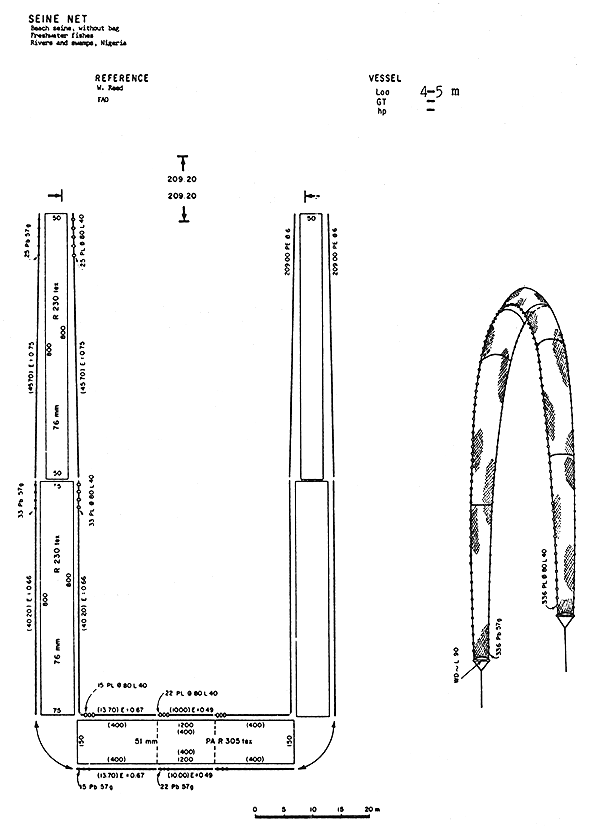
Fig. 4 Seine net
Also, in view of the great effectiveness of such gear, production and yields would have to be monitored to keep tabs on the state of fish stocks.
3.1.1.8 The Most Suitable Areas and Possible New Uses
Such purse seines are perfectly suitable for catching pelagic species in the great lakes or deep reservoirs. They increase the production of the pelagic zones in these waters which are often underfished. They could be introduced into most lakes of the Rift Valley. But the community aspect of this kind of fishing must be emphasized. However, groups or communities of fishermen are rare or non-existent on the shores of those great lakes. The example of Tanzania is unique. Before introducing such fishing methods, one has to investigate the possibility of setting up groups of fishermen. Loans must be provided for purchasing material and boats. Middlemen should be excluded if such fishing activities are to be of profit to the villagers.
3.1.2 Beach Seines
3.1.2.1 Types and Description
The beach seine with equal wings and pouch can be used successfully to exploit the resources of areas along the shores of the great lakes. It is effective but calls for bigger and more sophisticated initial investment and equipment than does the beach seine without a pouch described in this chapter.
This beach seine without a pouch which is drawn ashore is particularly interesting and simple for many kinds of fresh waters in Africa (Fig. 4). It is traditionally used in shallow waters where the bottom and the surface constitute natural barrages preventing fish from escaping encirclement. Its length varies from 50 to 400 m, with a drop of 2 to 8 m or more. Its meshes range from 10 to 200 mm from knot to knot, depending on the fish to be caught. The seine is put out from a sufficiently spacious boat driven by cars or a low-powered engine, which moves in an arc. The seine is later hauled ashore by hand by two teams of floats. The bottom rope is weighted to a greater or lesser extent, depending on the nature of the lake bed. The hauling ropes are fastened to either end of the seine.
3.1.2.2 Ease of Handling
This type of gear is extremely easy to use. It requires only a foreman or experienced fisherman to coordinate the operations. It is also simpler to make and maintain than a seine with a pouch.
3.1.2.3 Manpower
Depending on its size, the seine can be handled by a team of 6 to 42 men. Apart from the experienced fishermen, including the foreman, most of the others are unskilled men.
3.1.2.4 Initial Investment Cost
Depending on net size, seine fishing calls for an outlay of U.S.$ 250 to 2 500 at the outset. This gear is often highly efficient and very profitable. In addition, U.S.$ 50 to 300 must be allocated for buying a pirogue or a boat of planks.
3.1.2.5 Local Manufacture and Supply of Material
Such a net can be easily fashioned on the spot by using material bought locally. Floats can be made from light wood (ambatch, papyrus, etc.) or from calabashes or plastic bottles.

Fig. 5 Trawl
3.1.2.6 Upkeep, Repair and Durability
Upkeep and regular mending are necessary to make sure that the beach seine remains efficient. The net can be used for three to five years if fishermen replace the worn-out parts.
3.1.2.7 Impact on Environment and Rational Exploitation of Resources
Intra- and interspecific selectivity of such gear is slight. For instance, a seine having a mesh size of 30 mm from knot to knot catches both Tilapia sp. weighing less than one kg and Lates sp. weighing more than 30 kg. Seine fishermen therefore tend to use the smallest possible mesh, but the minimum is limited by the increase of resistance to haulage and the catching of too many specimens of excessively small size which are not profitable from a commercial point of view. The widespread use of too small mesh sizes, easily clogged by vegetation or debris of the lake bed, may thus destroy too great a proportion of immature fish, larvae and eggs, thereby throwing the fish populations out of balance.
Excessive use of this fishing method may also impair the environment:
it may destroy vegetation and remove plant debris rich in periphytic organisms;
it may increase water turbidity, with consequent clogging of the gills of fish, and
it may level the lake bottom to such an extent that certain biotopes needed for reproduction are destroyed.
Therefore, regulations are needed to limit the number of such beach seines.
3.1.2.8 The Most Suitable Environment and Possible New Uses
The use of beach seines might be promoted on very many small reservoirs or shallow lakes that are underfished, for instance in West Africa (Nigeria, Upper Volta, Ivory Coast, Benin) and in northwestern Tanzania. This fishing method should be employed by local communities near those lakes and could provide the population on the lake shores with a considerable quantity of cheap protein. But its expansion should be stopped in rivers (e.g., the Chari and the Senegal) where there is some risk of overfishing. In pisciculture, too, the beach seine can be used to harvest fish in ponds which have no adequate system for discharging water.
3.1.3 Trawls
3.1.3.1 Types and Description
Trawls are conical or pyramidal nets extending in front into wings of some length and towed by one boat (twin trawls) or two boats (pair trawls). Depending on the water depth at which the nets are operated, one distinguishes bottom and midwater trawls.
We are going to discuss only bottom pair trawls, i.e., nets pulled by two boats. In the southern part of Lake Malawi, this method is used successfully with boats equipped with 20 hp inboard engines and trawls whose stretched mesh is at least 25 mm. In that area, such trawls catch mainly numerous species of small cichlids about 10 cm long (Fig. 5).
3.1.3.2 Ease of Handling
This type of fishing calls for some training because each crew member has a specific job in lowering and heaving the net. In towing the net in a pair, the fishermen must also observe specific rules about the length of the dragropes, the distance between the two boats, and towing speed.
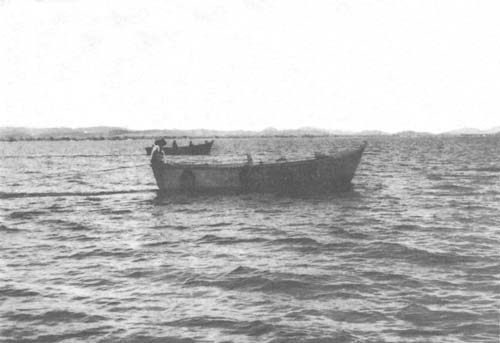
Fig. 6 Boats equipped with 20 hp inboard engine towing a pair trawl (Lake Malawi)
3.1.3.3 Manpower
Bottom pair trawling requires only a total of four to five fishermen for the two boats. Considering the relatively high cost of initial investment, they usually do not own the gear and boats and live solely on their wages.
3.1.3.4 Initial Investment Cost
| U.S.$ (1978 prices) | |
| 2 wooden boats, 5 to 6 m long | 8 400 |
| 2 inboard engines, 20 hp | 9 600 |
| 1 trawl | 600 |
| 2 reserve trawls, pieces of netting and yarn for repairs | 1 600 |
| Miscellaneous supplies: anchors, life-jackets, fire extinguishers, tools, floats, rope, etc. | 2 200 |
| Total | 22 400 |
In view of the considerable initial investment, loans should be granted as much as possible to the local populations to enable them to buy the equipment needed and to learn and practise this type of fishing.
3.1.3.5 Local Manufacture and Supply of Material
Fairly intensive training is necessary to manufacture this type of net. In Malawi, webbing is made in the country and can be ordered locally. All the ropes and other accesories can also be made or bought on the spot. Five to 6 m wooden boats (Fig. 6) are built at a small boatyard on the lake shore.
3.1.3.6 Upkeep, Repair and Durability
Appropriately maintained and used, such trawls can last one to two years at most. Boats and engines, if properly maintained, can be used for about 10 years.
3.1.3.7 Impact on Environment and Rational Exploitation of Resources
Repeated passages of trawls in a lake level the bottom and stir up clouds of mud, which is harmful to the multiplication of certain demersal fish species. Regulations should therefore limit the number of trawls and the areas of operations as well as lay down minimum mesh size. This is absolutely necessary in order not to destroy and depopulate fish fauna.
Excessive development of trawling would be at the expense of small-scale artisanal fisheries. Trawling should therefore be an additional activity aimed mainly at catching underfished species (e.g., small Haplochromis sp. in Lakes Victoria and Malawi).
3.1.3.8 The Most Suitable Environment and Possible New Uses
This type of trawling can be employed in waters 40 m deep at most, which limits its use in the very deep lakes of the African Rift Valley. It may be of interest in new large reservoirs if fishing channels are cleared of brush vegetation.

Fig. 7 Liftnet
3.1.4 Liftnets
3.1.4.1 Types and Description
Traditional liftnets have been used for decades in African rivers and lakes (e.g., the atalla of the Haussa in Nigeria, the portable square dipping nets on Lake Kivu). After remaining in the water for some time, they are lifted as fast as possible; the fish that happen to be above the net are caught while the water filters back.
The liftnet of Lake Tanganyika, operated from a catamaran, which is described below, should come into use on the great lakes of the Rift Valley and in reservoirs (provided that the water is transparent enough so that lamps can attract fish) (Fig. 7).
The method is well-suited to local artisanal fisheries. Moreover, it requires only low initial investment, so that a fisherman's family can easily afford it.
The net is lowered and remains stationary at a maximum depth of 25 to 30 m; one or more petroleum lamps (400 to 500 candles each) on the catamaran attract the fish (small clupeids and their predators) under the boat. After at least half an hour, the net is lifted by hand simultaneously at the four extremities of the catamaran by means of a system of booms and pulleys.
The effectiveness of the fishing gear depends on its size; it is preferable to use a net of 9 m by 9 (81 m2), rather than a net of 6 m by 6 (36 m2).
The catamaran, consisting of two hulls preferably of wood, may or may not be equipped with an outboard engine of about five hp, depending on the distance of the fishing grounds.
The method is not used during a full moon because the lamps are much less effective and the catch decreases accordingly.
3.1.4.2 Ease of Handling
After a very short training period, any fisherman can easily use the method. He merely needs some practice in handling the oil pressure lamps and some experience in assessing the concentration of fish under the lamps.
3.1.4.3 Manpower
A fishing boat of this kind requires a crew of four so that each of them can lift the net at one corner of the catamaran by means of a rope.
3.1.4.4 Initial Investment Cost
| U.S.$ (1977 prices) | |
| Catamaran built with 2 dugouts, or Catamaran built with 2 pirogues of planks | 200 to 1 000 |
| 2 nets, depending on size and quality | 500 to 800 |
| Engine, 4.5 hp | 600 |
| 3 lamps | 250 |
| Miscellaneous (booms, ropes, pulleys, etc.) | 200 |
| Minimum investment | 1 750 |
| Maximum investment | 2 850 |

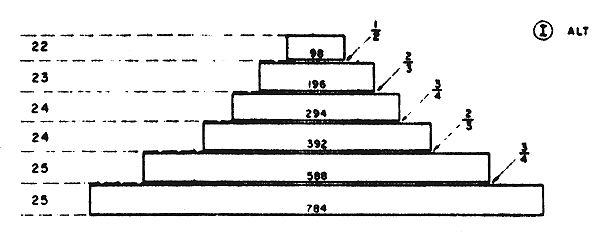
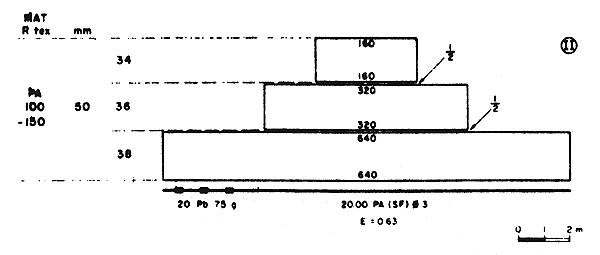
Fig. 8 Castnet

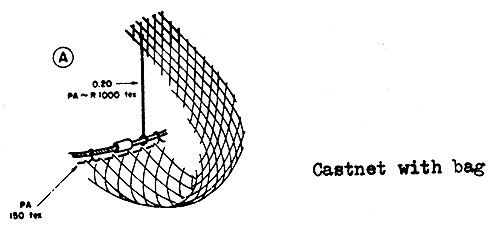
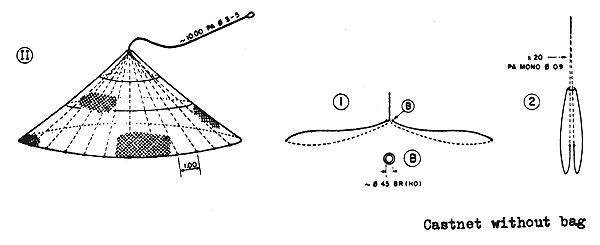
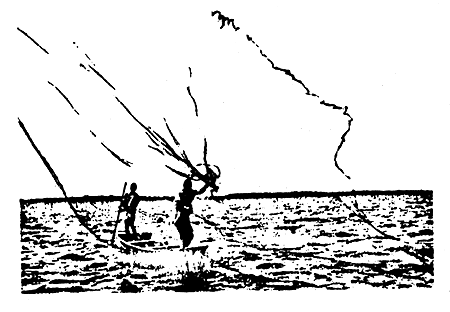
Fig. 9 Castnets
Repayable loans should be granted to customary and artisanal fishermen for this small initial investment. The government should lay down a policy to help such fishermen and enforce it. Loans should not be granted to traders or owners but to the fishermen themselves.
3.1.4.5 Local Manufacture and Supply of Material
The catamaran, which can be easily built by local carpenters, simply consists of two pirogues of planks lashed together. The net, too, is relatively simple and can be manufactured by a fisherman without great experience. Webbing and lamps are sometimes difficult to find locally and have to be imported in that case.
3.1.4.6 Upkeep, Repair and Durability
A net of this kind needs very little upkeep and may be used for about five years.
3.1.4.7 Impact on Environment and Rational Exploitation of Resources
The liftnet operated from a catamaran involves no danger to the environment. The risk of overfishing with this highly artisanal method is extremely slight, considering the resilience of the small pelagic species involved. A feature of the net in many cases is its high interspecific selectivity (catches of clupeids only in Lakes Kivu and Tanganyika, of cyprinids only in Lakes Malawi and Victoria, plus some predators: Lates sp., Luciolates sp., etc.). Liftnet fishing is perfectly geared to the rational exploitation of small pelagic species, which are frequently underfished even 2 or 3 km from the shores of the great lakes. In case of overfishing by gillnets, it enables traditional fishermen to change over to a new, simple and effective fishing method.
3.1.4.8 The Most Suitable Environment and Possible New Uses
The method is particularly appropriate in the large lakes of the Rift Valley, the waters of which are often exceptionally transparent. It might spread quickly if the supply of lamps and nets could be improved. It could develop on Lake Kivu (fishing of Limnothrissa sp., so far not exploited at all) as well as on Lakes Tanganyika, Malawi and other lakes rich in planktonophagous pelagic fish.
3.1.5 Castnets
3.1.5.1 Types and Description
The net is cast over fish and catches them by closing on them as it is withdrawn. Its use is normally limited to shallow waters.
These nets, employed on most inland waters of Africa, are cast by hand only and have a diameter of 3 to 9 m (Fig. 8). They have stretched mesh of 10 to 70 mm and may be fitted with bags above the weighted rope and bag lines (Fig. 9). The nets are cast from shore, in waist-deep water or from pirogues.
3.1.5.2 Ease of Handling
Some practice is needed for handling such gear effectively. Casting calls for perfectly coordinated movements of body, legs and arms.
3.1.5.3 Manpower
Castnet fishing is the prototype of individual fishing, even though a paddler's help is sometimes needed. Under certain conditions, however, a number of fishermen get together to cast their nets at the same time, which makes for greater efficiency of their gear.
3.1.5.4 Initial Investment Cost
The castnet is a very cheap type of gear. Between U.S.$ 10 and 50 will buy the webbing, small cord and weights needed to fashion it. It can even be made entirely by hand from nylon yarn.
3.1.5.5 Local Manufacture and Supply of Material
The net can be easily manufactured locally with webbing or yarn found on the spot.
3.1.5.6 Upkeep, Repair and Durability
If used on uneven beds with many obstacles, the castnet needs regular upkeep and many repairs. In this case, it may last less than six months. But if used in waters without obstacles, it may be usable for more than one or two years.
3.1.5.7 Impact on Environment and Rational Exploitation of Resources
The manual castnet employed intensively may be harmful to fish populations in specific cases, for example, if it has very small meshes and catches immature species living in schools or swarms (e.g., young Heterotis spp.). In very intensive use it may also affect some populations by catching parent fish during the period of reproduction (e.g., Tilapia spp. which multiply in shallow water).
Regulations should therefore protect such natural resources by banning castnets with exceedingly small meshes and this method in certain areas and during the period of reproduction.
3.1.5.8 The Most Suitable Environment and Possible New Uses
Castnets can be used in a variety of environments, from rivers with a strong current to shallow lakes or stagnant swamp waters. It could be profitably used by many customary or artisanal fishermen as an additional type of gear when their habitual methods produce unsatisfactory results.
3.1.6 Gillnets
3.1.6.1 Types and Description
The use of gillnets is widespread in nearly all inland waters of Africa following the appearance of nylon. The gillnet works as follows: fish are netted, entangled or caught in webbing suspended vertically in the water. A single gillnet may be used or a series, one after another (sometimes extending over more than 1 000 m).
The gillnet may be set or fixed, that is, anchored or extended between posts, directly on the bottom or in midwater; it may also drift under the surface or in midwater. In this case, it may drift by itself or fastened to a boat.
Mesh size ranges from 20 to 200 mm or more (stretched mesh), depending on the fish to be caught. As a rule, the webbing is made of multifilament or monofilament nylon or poly-mide (PA). The monofilament type is seldom used in Africa because it is more difficult to handle and repair. On the other hand, owing to the great effectiveness of monofilament nylon in clear waters, its use is sometimes subject to regulations in some regions.
The thickness of multifilament yarn varies, depending mainly on mesh size which, in turn, depends on the size of the fish species to be caught. In general, it is R 100 tex or 10 000 m/kg (fine yarn often used with 50 mm mesh for catching Tilapia spp.), R 155 tex or 6 460 m/kg, or R 320 tex or 3 130 m/kg (thicker yarn used with 80 mm mesh for catching Labeo spp. or Citharinus spp.).
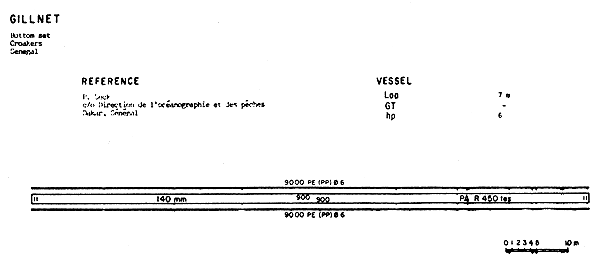
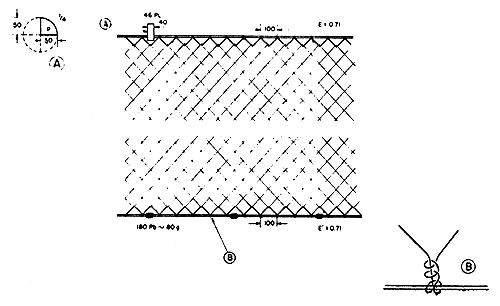

Fig. 10 Gillnet

Fig. 11 Change in numbers of species caught according to mesh size in River Senegal
Fixed gillnets are usually more effective at night than by day and are checked every morning (Fig. 10).
3.1.6.2 Ease of Handling
Simple to put out and raise, the set nets are often left in place for several days. During this period they are inspected daily to remove the entangled catch. Some fish species (e.g., Synodontys spp.) can be very difficult to remove because of their stinging spines.
3.1.6.3 Manpower
A gillnet fishing unit generally consists of two men fishing in the same pirogue. Sometimes there is only one fisherman who paddles with one hand and puts out or raises his net with the other (especially when a drifting gillnet is used).
3.1.6.4 Initial Investment Cost
This type of fishing generally involves low initial investment costs. For example, a fisherman using a drifting gillnet needs a 150 m net with a drop of 2 m, which costs from U.S.$ 50 to 100 (1978 price), depending on nylon quality, mesh size and yarn thickness. A series of set or fixed gillnets costs much more because of the greater net length. In addition, he has to spend U.S.$ 50 to 150 to buy a dugout or a pirogue of planks.
3.1.6.5 Local Manufacture and Supply of Material
Such nets are always assembled on the spot with webbing made by small domestic plants or imported from abroad and sold on most markets in Africa.
3.1.6.6 Upkeep, Repair and Durability
Few professional fishermen mend their gillnets. Also, it is rare that such nets, when not in use, are properly suspended in the shade to prolong their effectiveness.
A gillnet may last two or three months, sometimes it may be used for up to one year.
There is a general tendency to use increasingly finer yarn which is cheaper and more efficient but which has a very short life. Current, but questionable, practice is to discard and replace a net when it is worn out or has holes.
3.1.6.7 Impact on Environment and Rational Exploitation of Resources
The gillnet is a highly selective gear. Depending on mesh size, assembly and the way it is set or drifts, it catches fish of different size or species. The number of species caught diminishes very often in line with mesh size (Fig. 11). This net often fits in perfectly with the environment in which it is used. But sometimes it may give rise to overfishing of one or more species. In some rivers, there is sometimes a multitude of drifting gillnets which block the ascent of mature migratory fish (e.g., Alestes spp. in the Chari-Logone). Such barrages must be applied with caution. On the other hand, minimum mesh size of gillnets should be determined in keeping with the quantity and composition of stocks.
When the gillnet is used in warm and poorly oxygenated waters, it may cause considerable waste of fish. After being caught in the mesh, they die quickly and rot in a few hours.
3.1.6.8 The Most Suitable Environment and Possible New Uses
The set or drifting gillnet can be used virtually everywhere and at all times. Its use should be spread in villages near the many underfished small reservoirs. It would be very useful in areas where other fishing methods are not applied.

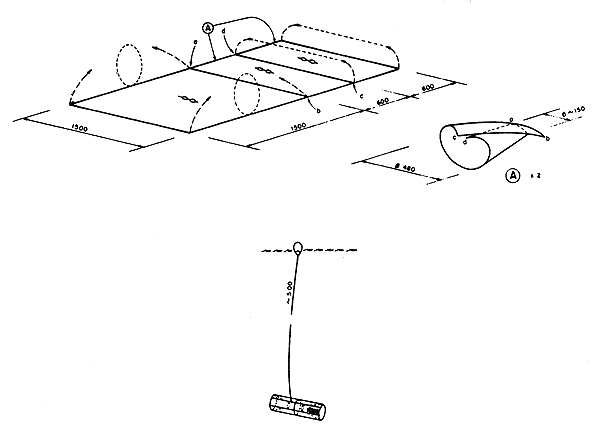
Fig. 12 Pot
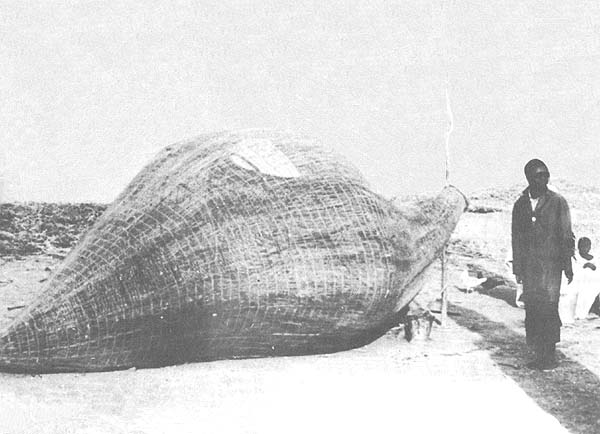
Fig. 13 Pot made with local material (River Niger)
3.1.7 Pots
3.1.7.1 Types and Description
Pots are fixed gear which fish enter through labyrinths or other devices, such as bottlenecks or funnels, that keep them prisoner.
There are very many types and forms of pots made from natural locally produced materials (wicker, liana, lathing, bark, wood, etc.) or from nylon webbing mounted on wooden or metal frames. Another interesting material is the galvanized gridiron, which is cheap and can be easily worked to make such gear (Fig. 12).
Pots may be unbaited or baited with fish waste, chicken offal, etc. In Africa, they are often used together with lattice barrages or bunds which guide the fish toward the chamber where they are caught.
3.1.7.2 Ease of Handling
No special training is needed to use pots. But their manufacture requires some skill, and the fisherman must know where fish pass so that he can place the gear accordingly and obtain profitable results.
3.1.7.3 Manpower
In addition to his usual material, the individual fisherman may have about ten pots which he raises daily. In this way he can increase his catch considerably without effort.
3.1.7.4 Initial Investment Cost
A pot may cost less than U.S.$ 1 and up to U.S.$ 10, depending on whether the fisherman uses local plant material, nylon netting or galvanized gridiron.
3.1.7.5 Local Manufacture and Supply of Material
All these pots are made on the spot by fishermen. As said, they use either natural material collected in the bush (Fig. 13) or grills or netting sold on most local markets.
3.1.7.6 Upkeep, Repair and Durability
Such gear requires practically no upkeep and few repairs. Pots made from plant material may last a few months, galvanized metal pots more than two years.
3.1.7.7 Impact on Environment and Rational Exploitation of Resources
Pots are of special interest in places heavily infested with water or swamp plants, where other fishing gear cannot be used. They can in no way affect the rational exploitation of fishery resources. Pots are highly selective and catch fish that normally live in such vegetation-rich environment (Polypterus spp., Ctenopoma spp.), species seldom found in catches produced by other fishing methods.
Mesh size should be chosen in such a way that too small or immature fish can escape. The intensive use of pots together with barrages requires careful investigation because their large-scale and continuous employment may be harmful to the migration of spawning fish.
3.1.7.8 The Most Suitable Environment and Possible New Uses
Pots can be used in all types of aquatic environment in Africa. They could be recommended when small or large reservoirs are created, in places where the original brush flora obstructs the bottom and shores of such man-made lakes. They are especially appropriate in marshy shallow areas as a supplementary fishing activity.
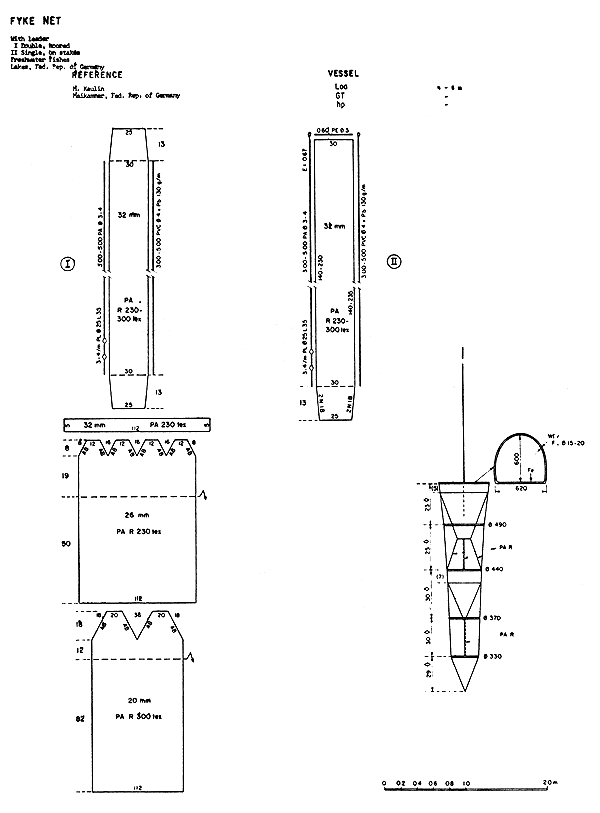
Fig. 14 Fyke net
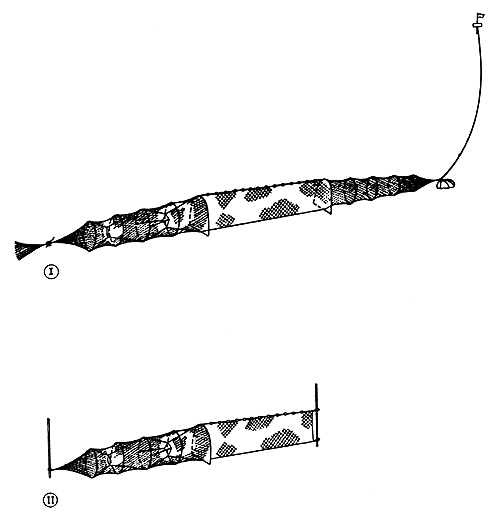
Fig. 15 Fyke net
3.1.8 Fyke Nets
3.1.8.1 Types and Description
Virtually non-existent in tropical Africa, but found in North Africa, these nets are fixed and can be used singly or in groups, equipped with wings and guiding vanes. The part which catches the fish generally is in the shape of a basket or cage of netting in a wooden or metal frame.
The barrier fyke net is of particular interest for artisanal fisheries in Africa because of its simplicity and relatively low cost. It can be single or double, anchored or stretched between posts. The anchored type may be used in water 10 m deep or more, while the type between pots may be used only in water with a maximum depth of 3 to 4 m (Figs.14 and 15).
No bait is needed; fish are guided by the barrier(s) into the chamber where they are caught.
3.1.8.2 Ease of Handling
Such gear can be easily handled by skilled or unskilled fishermen. Nevertheless, care is needed in making the trap or chamber, and especially the cutting and assembling of the bottlenecks. Some practice is also needed in locating the best sites for a good catch.
3.1.8.3 Manpower
Like pots, fyke nets are perfectly suitable for the fisherman who fishes on his own. The net must be raised once or twice a day if the water is warm to prevent the fish from dying and rotting; in cool and oxygenated water, the net may be inspected every two or three days.
3.1.8.4 Initial Investment Cost
As a rule, a small barrier fyke net is an inexpensive type of gear. The material needed for a simple fyke net with posts, about 5 m long, does not exceed U.S.$ 50 (this includes wooden hoops, floats, nylon webbing, ropes and posts). A pirogue or small boat is also needed to raise the net. But it should be pointed out that fyke nets can also be of large size; for instance, set nets with barriers and guiding vanes may cover 50 m or more. In this case, they cost much more (U.S.$ 500 to 1 000), and a group of fishermen is therefore required to operate them.
3.1.8.5 Local Manufacture and Supply of Material
Manufacture of fyke nets calls for some practice in cutting and assembling, but involves no major difficulty.
The material needed can be found locally, except perhaps for netting.
3.1.8.6 Upkeep, Repair and Durability
In general, fyke nets require very few repairs. Upkeep normally is confined to cleaning from time to time to remove algae, water plants, sponges or debris which may clog the netting. Properly made with durable material, fyke nets may last five years at most.
3.1.8.7 Impact on Environment and Rational Exploitation of Resources
To be fully effective, a fyke net should remain in one place only for a few weeks and should be shifted at regular intervals. Like pots, it has no harmful impact on its environment. As in the case of other nets, the mesh size of the chamber where the fish are caught, which determines selectivity, should be chosen in line with the fish stocks to be exploited.
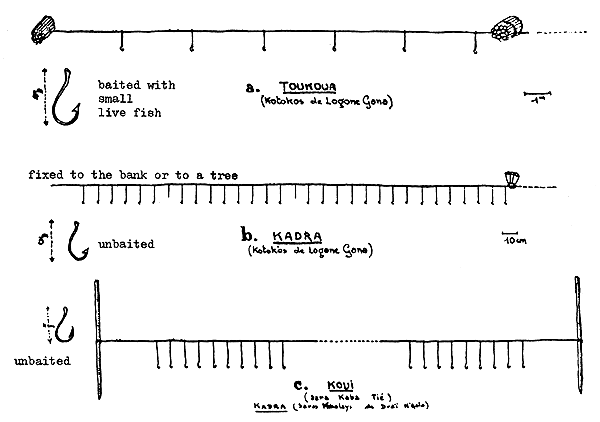

Fig. 16 Different kinds of longlines used in the Logone-Chari Basin
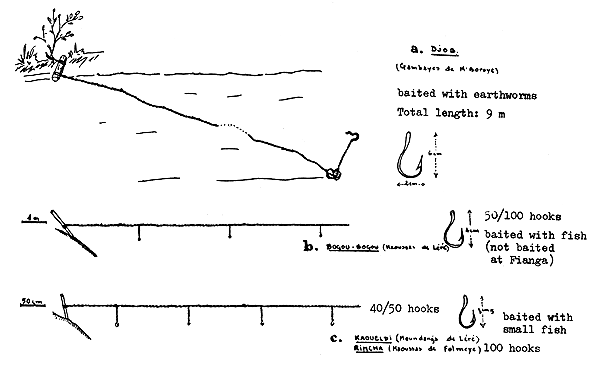
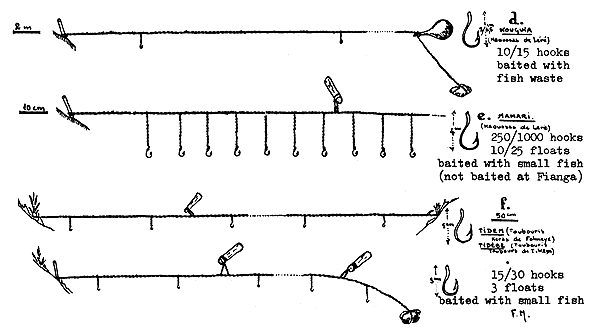
Fig. 16a Different kinds of longlines used in the Logone-Chari Basin
3.1.8.8 The Most Suitable Environment and Possible New Uses
Fyke nets are best suited for swampy shallow lakes, areas along the shores or reservoirs or other deeper lakes, and stagnant arms of rivers or streams. They should be recommended for use in most fresh waters of Africa.
3.1.9 Hooks-and-Lines
3.1.9.1. Types and Description
Fish are attracted by natural or artificial bait and caught on one or more hooks fastened to a line. We describe here only longlines, the most interesting type from the standpoint of production (Figs. 16 and 16a).
Unbaited lines are also used to catch fish which swim near the hooks. Apart from hand lines, the main lines employed in Africa are longlines (or set lines), whether baited or not. They may have up to 5 000 unbaited hooks for a total length of 500 to 1 000 m (as used by the Haussa in Nigeria). The longlines sometimes have 20 evenly spaced papyrus or ambatch floats which keep the line in midwater.
The most widely used hooks on such lines are of the Kirby type with a ring; their size ranges from No. 1 to No. 15, depending on the fish to be caught.
Many kinds of bait are used, from small pieces of soap to land snails or insects (termites) or small live or dead fish.
3.1.9.2 Ease of Handling
The longline is one of the easiest fishing devices to handle and to make.
3.1.9.3 Manpower
A longline can be used very well by one fishermen with a pirogue.
3.1.9.4 Initial Investment Cost
The longline is a very cheap device; all fishermen can afford it. The price of hooks (No. 1 to 15) ranges from U.S.$ 120 to 10 per 1 000. To this must be added U.S.$ 4 for a main line (R 300 tex yarn) about 1 000 m long and 1 000 leaders (R 155 tex) of 25 cm each.
3.1.9.5 Local Manufacture and Supply of Material
All longlines are made locally by fishermen. Hooks and nylon yarn are usually imported and sold by small traders in local markets.
3.1.9.6. Upkeep, Repair and Durability
Properly used, such gear needs only very little upkeep and repair. The hooks may have to be straightened and sharpened from time to time. When leaders or hooks get lost, they are simply replaced. A longline can be used for at least one to two years.
3.1.9.7 Impact on Environment and Rational Exploitation of Resources
Baited longlines catch mainly bottom-dwelling fish and can therefore supplement fishing based on surface gillnets. As their productivity is often heightened by water transparency, longlines might replace especially liftnets during the full moon when liftnets are not used for lack of a catch. The selectivity of longlines, determined mainly by hook size, may be regarded as satisfactory. Their impact on the environment is practically nil.
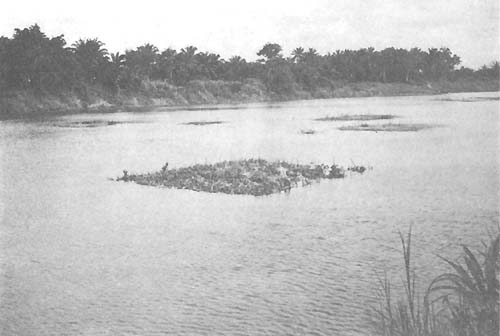
Fig. 17 Fish refuges used in the Lower Oueme (Benin)
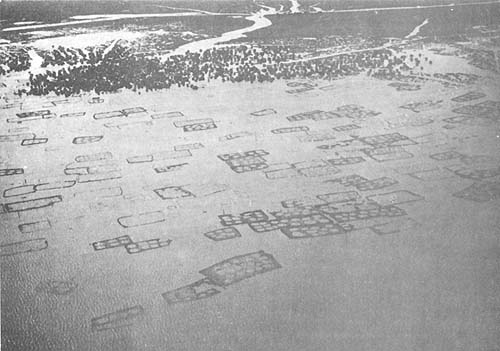
Fig. 18 Aerial view of acadjas in the Lower Oueme (Benin)
3.1.9.8 The Most Suitable Environment and Possible New Uses
The longline may be used in waters of varying depth, but it gives particularly good results at a depth of 0.5 to 2 m. It is specially suited to catching numerous African silurids, such as Clarias spp. It is also employed in shallow lakes of Central Africa to catch Gymnarchus niloticus. Its use may also become widespread on many new reservoirs and elsewhere, in addition to liftnets and gillnets.
3.1.10 Acadjas and Fish Refuges
3.1.10.1 Types and Description
The acadjas of West Africa are a fishing technique that uses a fish park of plant branches built by lagoon fishermen.
There is a similar but simpler type in the Niger, Logone-Chari and Benue Rivers. In these rivers, piles of branches, or fish refuges, are put into the water, then withdrawn after a few days or weeks (Fig. 17).
The fish which have taken refuge in them are caught.
The lagoons, on the other hand, semi-permanent fish parks, not only provide profitable catches but also serve to restock the surrounding waters.
These fishing methods are always used in relatively calm and shallow waters (1.5 to 2 m at most).
3.1.10.2 Ease of Handling
Such fish refuges can be easily handled and inspected every week. A fisherman therefore can deal with about ten refuges. He fishes them by encircling them with a sort of seine or barrage or reed lattice and then catches the fish with a spoon net.
Acadjas of about 10 m in diameter or more are fished four to five times a year. In this case, reed lattice is replaced with a net. The bigger acadjas have to be operated by a team of skilled fishermen (Fig. 18).
3.1.10.3 Manpower
Fish refuges can be operated very well by the customary or artisanal fisherman working alone or with his family. But the bigger acadjas require up to 10 fishermen or more.
3.1.10.4 Initial Investment Cost
The investment cost of fish refuges is insignificant provided that a large quantity of branches is available in the area. Some netting to encircle the refuges or to fashion one or two spoon nets is the only other material needed for this kind of fisheries.
By contrast, the cost of a big acadja, like the ones on Lake Nokoue in Benin, is relatively high (more than U.S.$ 500 per ha, with U.S.$ 200 per ha to replace the branches).
3.1.10.5 Local Manufacture and Supply of Material
For economic reasons, the material used for this type of fishing should always be obtained on the spot. To manufacture the acadjas, fishermen cut tree branches, reed or palm fronds growing in the area; they choose them for their fish-attracting quality. The individual fisherman may thus have his plantation for his personal use.
Nets with a mesh size of about 15 mm can be bought even in the remotest places.
3.1.10.6 Upkeep, Repair and Durability
In lagoons, 50 to 75 percent of the branches must be replaced annually when they begin to rot or are attacked by wood-boring molluscs. Losses are lower in rivers.
3.1.10.7 Impact on Environment and Rational Exploitation of Resources
The general principle of acadjas is to recreate artificially the favourite habitat of certain fish species. Such artificial environment offers some protection against predators, ideal places for reproduction and, above all, an abundant source of feed, periphyton on the branches and benthic fauna on plant debris on the bottom.
In the lagoons of Benin, the main species fished in acadjas are Tilapia spp. and Chrysichthys spp., which are in great demand on local markets and in towns.
The factors governing rational exploitation of fishery resources in acadjas are:
type of installation;
density of branches; and
fishing frequency.
On the whole, it may be said that acadjas make for increased fish production because in addition to giving interesting results they also play a favourable role in restocking the waters in which they are operated.
The ecological role of small fish refuges is debatable. Even so they are a supplementary fishing method of interest to the individual fisherman.
3.1.10.8 The Most Suitable Environment and Possible New Uses
This fishing method is suitable for calm shallow waters of lagoons, rivers, streams and lakes with sandy or muddy bottom so that branches can be fixed in it. Its use could be spread throughout Africa on a much larger scale than is the case at present.
3.1.11 Ponds and Small Dams
3.1.11.1 Types and Description
On African plains subject to flooding from time to time, the development of man-made ponds (whedoes), of barrages blocking drainage channels and of dams enclosing certain areas would substantially improve fishery production because it keeps such areas under water during the dry season. Such areas are fished before the onset of the rainy season. These water reserves protect fish from useless death and the fish can continue growing for the fisherman's benefit.
The success of the method often depends on the migration of fish from the flooded plain toward the artificial depression when the waters recede after the high-water season.
3.1.11.2 Application
This method can only be used by village communities or groups of fishermen because it requires abundant manpower but no specific technology is needed, apart from intuitive knowledge of topography of the terrain and some rudiments of civil engineering.
3.1.11.3 Manpower
As said, the method calls for occasional collaboration of many villagers and fishermen for making the ponds, channels and dams and for the fishing operations. The method therefore must fit in smoothly with the customs of the inhabitants on the plains.
3.1.11.4 Initial Investment Cost
Digging and other earthwork should be done manually by the villagers on a voluntary basis, as is done for example in some areas of Senegal (in the Senegal River Basin) or in Benin (on the Lower Oueme River).
For fishing, only enclosures or palm-leaf matting, wicker baskets, matchets and spoon nets are needed to encircle and catch the fish sector by sector.
3.1.11.5 Local Manufacture and Supply of Material
The few materials and tools needed for such operations can be obtained locally everywhere.
3.1.11.6 Upkeep, Repair and Durability
Such fishing operations can be repeated year after year without too much work on the installations. After fishing, excessive mud and vegetation should be removed and the banks reshaped.
3.1.11.7 Impact on Environment and Rational Exploitation of Resources
These artificial water areas, which are kept under water during the dry season, retain part of the fish which would otherwise descend toward the stream where they lack adequate living space or would perish when pools dry up. The composition of fish species varies, depending on whether the water area is small and infested with floating vegetation (poorly oxygenated water containing mostly silurids) or whether it is of larger size with less vegetation (higher oxygen content and a greater number of species).
It should be pointed out that an excessive number of barrages may considerably interfere with migration downstream, throwing the future fishery potential out of balance.
3.1.11.8 The Most Suitable Environment and Possible New Uses
Such fishing operations are of great interest on all plains subject to flooding from time to time. Not only can they substantially boost fish-protein production but they can also facilitate the development of other activities (farming, animal husbandry) around these permanent water areas.
Creation of such water areas should be encouraged, especially in the areas of the Logone-Chari, the marshy zones of the Niger, etc.
3.1.12 Floating Cages
3.1.12.1 Types and Description
The introduction of intensive fish breeding and control in floating cages could substantially raise fish production in African streams, lakes and lagoons.
As for frame size and shape, there are many different combinations in line with the materials available. Size may range from 1 m3 for fry to more than 100 m3 for the fattening of adults. A frame may be made of wood, bamboo, steel pipe, etc. The walls often consist of galvanized grille, plastic grille, bamboo or nylon yarn. The cages float by means of blocks of expanded polystyrene, drums of plastic or other material, light wood (e.g., ambatch) (Fig. 19).
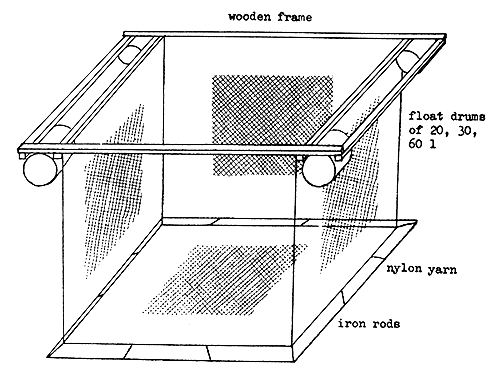
Fig. 19 Model of breeding cage (dimensions according to material available locally)
Successful introduction of these new breeding systems calls for the establishment of a service for producing, gathering and distributing selected fry from private or government hatcheries. At the same time, a system for extension work and assistance should be set up.
This breeding system is only in an experimental stage in Africa. The main species involved are Tilapia nilotica, T. esculenta and T. zilii, as well as Clarias lazera.
3.1.12.2 Application
Cage breeding can only be undertaken in areas where cheap agro-industrial waste (from breweries, rice and other mills) is available. Such waste is used locally to manufacture granules for fish. This feed must be distributed by hand several times a day. Some experience is also necessary to handle and sort the fish. Practical training should be provided before development activities are undertaken in the field.
3.1.12.3 Manpower
Fish could be cultivated in cages by individual fishermen or by villages or communities of fishermen. Every fisherman could possess several cages and look after them in addition to his normal work.
3.1.12.4 Initial Investment Cost
In Ivory Coast, a 6 m3 cage of durable material (plastic screen, plastic drums) costs U.S.$ 100 (1977 price). It may be much cheaper if local, less durable material is used (bamboo, local wood, etc.).
To this must be added the purchase of a few square metres of mosquito netting for the spoon nets to handle the fry. A pirogue or a boat is also needed for regular inspection of the cages (feeding, upkeep, emptying, etc.).
3.1.12.5 Local Manufacture and Supply of Material
Such cages can be easily made by the fishermen themselves, largely with local material.
3.1.12.6 Upkeep, Repair and Durability
Upkeep and repair depend above all on the material used for the cages. They may last one to five years, according to the material, whitewood or more durable material (metal, redwood, plastic grille).
3.1.12.7 Impact on Environment and Rational Exploitation of Resources
Such fish breeding does not impair the environment. But sites for cages in lakes and lagoons should be carefully chosen. If they are put in shallow water (less than 5 m), there is a greater risk of deoxygenation when the water turns or during the hotter periods of the year. Also, excessive feed may have similar effect in stagnant water.
3.1.12.8 The Most Suitable Environment and Possible New Uses
Such breeding is particularly appropriate in overfished waters, e.g., in the lagoons of West Africa. If part of the fishermen change over to pisciculture, fish production would be increased and the fishing effort involving overfished stocks would be reduced.
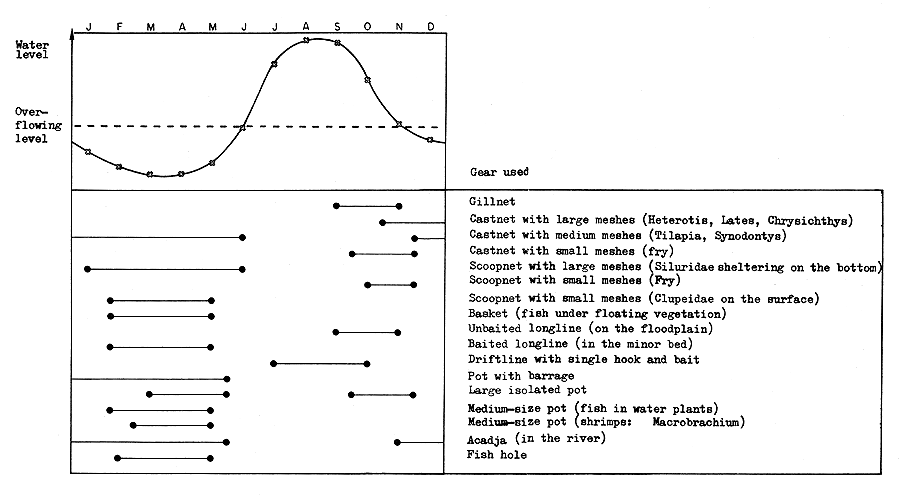
Fig. 20 Fishing-gear utilization in the Lower Oueme in the course of a year (pers. comm. Welcomme, 1979)

| MAIN PARTICULARS | ||
|---|---|---|
| Length over all | 5.10 m | (17 ft) |
| Beam over all | 1.14 m | (3 ft 9 in) |
| Depth | 0.40 m | (1 ft 4 in) |
| Weight approx. | 170 kg | |
| Propulsion: | paddling or outboard up to 5 hp | |
| Purpose: | gillnetting, handlining, general purpose | |
Fig. 21 Flat bottom plank pirogue (5.10 m) designed for Lake Kossou and built at artisanal boatyards

Fig. 22 Plank pirogue built at Kossou (Ivory Coast)
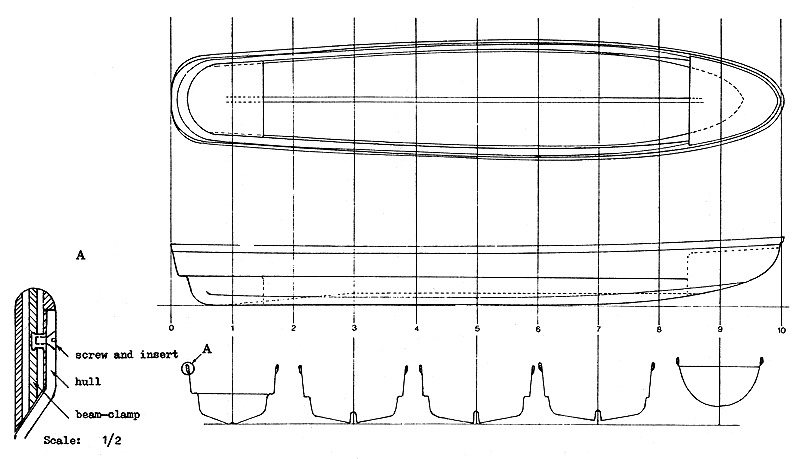
Fig. 23 Fibreglass pirogue
3.1.13 Use and Interaction of Different Types of Gear
For rational exploitation of natural resources, fishing gear should be well adapted to local conditions which often vary greatly with the seasons, water level, the behaviour of fish, migrations of species, etc. Fishermen therefore very often use a number of different gear in line with the time of year to make optimum use of the environment. A typical example of fishing-gear utilization in the course of the year is the Lower Oueme River valley in Benin (see Fig. 20).
On the other hand, it should be pointed out that the use of certain types of gear tends to exclude the use of other fishing methods; for instance, trawling is impossible where gillnets are employed. Likewise, gillnets and castnets cannot be used in waters where many longlines are employed, because they may get entangled.
3.2.1 Development
Dugouts are still the most frequent boats on most inland waters of Africa. But as the price of timber increases, it would appear that the artisanal construction of pirogues made of planks or glassfibre is going to develop rapidly.
3.2.2 Pirogues made of Planks
Construction with planks makes for more rational use of massive wood.
Several types of pirogues, designed for Lake Kossou (Ivory Coast), are being built with local material at artisanal boatyards. With an overal length of 5.5 m and a beam of 1.10 m, the pirogue weighs about 110 kg. It is propelled by paddles. It is designed to carry a maximum of three fishermen. Construction cost was about U.S.$ 50 in 1973 (i.e., about U.S.$ 100 today), for an average life of three years.
At present, such a plank pirogue would seem of greater interest in Africa because it uses local labour and material. Because of its modest cost, it can be bought by small-scale fishermen (Figs. 21 and 22).
3.2.3 Fibreglass Pirogues
This pirogue generally requires expensive imported material, such as glassfibre, polyester resin, gelcoat, solvents and catalysts, etc.
In Zambia, the cost price of a 5.40-m long glassfibre pirogue with a beam of 1 m was about U.S.$ 370 in 1977. The boat weighs less than 100 kg and can carry more than 500 kg. It may be used up to ten years (Fig. 23).
This type would appear to be of interest to the Sahelian countries which are very poor in sawn wood.
3.2.4 Transport Boats
Big single-trunk pirogues more than 15 m long which are used to carry goods and fish are being gradually replaced by transport boats of planks or marine plywood. Such locally built boats are poorly designed and unfit for their purposes. Their finish and durability also are inadequate.
Two types of boats made of planks that are suitable for collecting and carrying fish would seem of special interest to local artisanal boat yards: SOM-1 and IUC-7.
| MAIN PARTICULARS | ||
|---|---|---|
| Length over all | 8.43 m | (27 ft 8 in) |
| Beam over all | 2.26 m | ( 7 ft 5 in) |
| Depth | 0.76 m | ( 2 ft 6 in) |
| Weight approx. | 945 kg | |
| Carrying capacity up to 2 tons of payload | ||
| Propulsion: outboard up to 20 hp, heavy duty type | ||
| Purpose: transportation on lakes and rivers or multi purpose fishing boat on protected coast. | ||
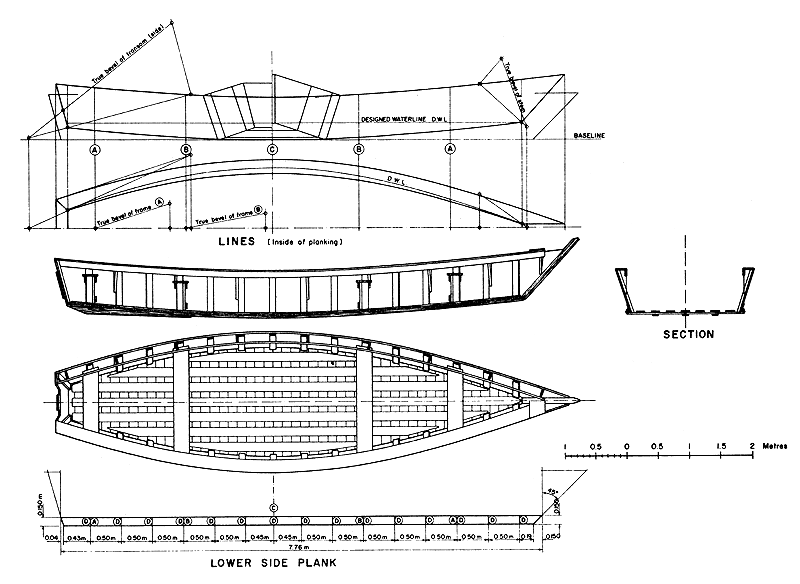
Fig. 24 8.43 m Transport boat
| TIMBER: |  |  |  |  |  |  |  |
| Weight pr.m(at 0.65kg/dm3) | 4.87 kg | 2.44 kg | 1.37 kg | 3.42 kg | 2.50 kg | 0.82 kg | 3.70 kg |
| Side planking | 55.00 m | 35.00 m | |||||
| Bottom planking | 75.00 m | ||||||
| Frames | 24.00 m | ||||||
| Stem pieces | 1.40 m | 1.40 m | |||||
| Transom | 0.50 m | 4.50 m | 1.70 m | ||||
| Side stiffeners | 24.00 m | ||||||
| Sheer clamp | 18.00 m | ||||||
| Covering board | 18.001m | ||||||
| Bottom reinforcements | 42.00 m | 20.00 m | |||||
| Skeg | 2.00 m | ||||||
| Chine | 17.00 m | ||||||
| Thworts and knees | 8.00 m | 10.00 m | |||||
| Chine botten | 16.00 m | ||||||
| Total length | 26.50m | 200.00m | 17.00m | 39.50m | 73.10m | 16.00m | 1.40m |
| Weight | 100 kg | 488 kg | 23 kg | 135 kg | 183 kg | 13 kg | 5 kg |
1 Covering board to be shaped from 25 × 300 to 25 × 200 finished
The timber should preferably be medium heavy and medium hard with good holding power for nails and low tendency to split.
For maximum durability, the timber should be treated with the best locally available impregnation system, preferably pressure impregnation of all planks before the construction.
CAULKING:
All joints should be treated with an asphalt - based or bitumastic compound during the construction. It may be necessary to caulk eventual bad leaks with caulking cotton afterwards.
FASTENINGS:
For assembly of frames: galvanized 60 × 5 mm wood screws
For planking : 70 × 3.5 mm galvanized round nails.
Elsewhere : 60 × 3.0 mm or 70 × 3.5 mm galvanized round nails
BUILDING INSTRUCTIONS:
See Boat No IVC - 7, Drawg. No. 3
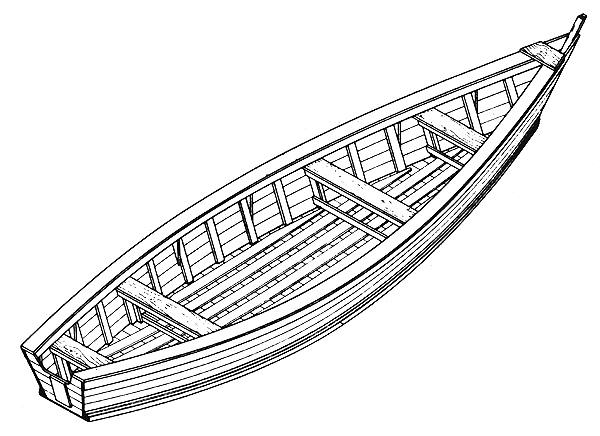
| MAIN PARTICULARS | ||
| Length over all | 8.43 m | (27 ft 8 in) |
| Beam over all | 2.26 m | ( 7 ft 5 in) |
| Depth | 0.76 m | ( 2 ft 6 in) |
| Weight approx. | 945 kg | |
| Carrying capacity up to 2 tons of payload | ||
| Propulsion: outboard up to 20 hp, heavy duty type | ||
| Purpose: transportation on lakes and rivers or multi purpose fishing boat on protected coast. | ||
Fig. 24a 8.43 m Transport boat
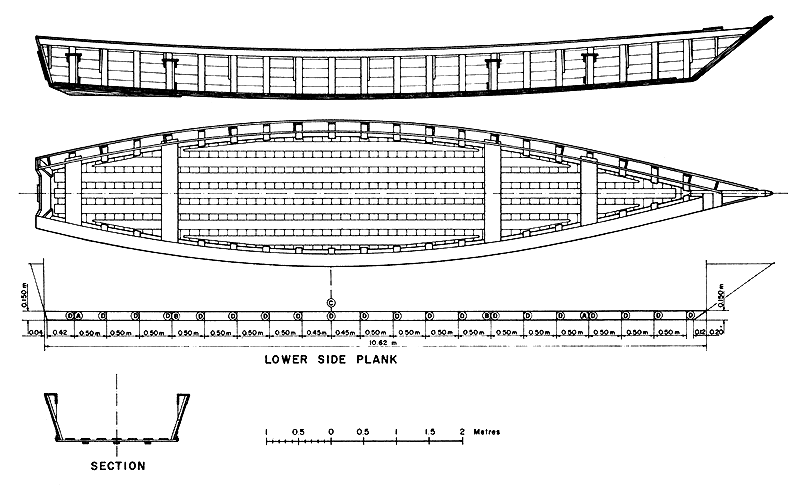
| MAIN PARTICULARS | ||
| Length over all | 11.25 m | ( 36 ft 10 in ) |
| Beam over all | 2.24 m | ( 7 ft 4 in ) |
| Depth | 0.76 m | ( 2 ft 6 in ) |
| Weight approx. | 1220 kg | |
| Carrying capacity up to 3 tons of payload | ||
| Propulsion : outboard up to 20 hp, heavy duty type | ||
| Purpose : transportation on lakes and rivers | ||
Fig. 25 11.25 m Transport boat
| TIMBER: |  |  |  |  |  |  |  |
| Weight pr.m (of 0.65 kg/dm3) | 4.87 kg | 2.44 kg | 1.37 kg | 3.42 kg | 2.50 kg | 0.82 kg | 3.70 kg |
| Side planking | 74.00 m | 48.00 m | |||||
| Bottom planking | 100.00 m | ||||||
| Frames | 23.00 m | ||||||
| Stem piece | 1.60 m | 1.60 m | |||||
| Transom | 0.50 m | 2.50 m | 1.70 m | ||||
| Side stiffeners | 32.00 m | ||||||
| Sheer clamp | 22.00 m | ||||||
| Covering board | 23.00 m1 | ||||||
| Bottom reinforcements | 58.00 m | 28.00 m | |||||
| Skog | 2.00 m | ||||||
| Chine and batten | 22.00 m | 22.00 m | |||||
| Thwarts and knees | 8.00 m | 14.00 m | |||||
| Total length | 31.50 m | 268.00 m | 22.00 m | 50.50 m | 88.30 m | 22.00 m | 1.60 m |
| Weight | 117 kg | 654 kg | 30 kg | 173 kg | 221 kg | 18 kg | 6 kg |
1 Covering board to be shaped from 25 × 300 to 25 × 200 finished.
The timber should preferably be medium heavy and medium hard with good holding power for nails and low tendency to split.
For maximum durability, the timber should be treated with the best locally available impregnation system, preferably pressure impregnation of all planks before the construction.
CAULKING:
All joints should be treated with an asphalt - based or bitumastic compound during the construction. It may be necessary to caulk eventual bad leaks with caulking cotton afterwards.
FASTENINGS:
For assembly of frames: galvanized 60 × 5 mm wood screws.
For planking : 70 × 3.5 mm galvanized round nails.
Elsewhere : 60 × 3.0 mm or 70 × 3.5 mm galvanized round nails.

| MAIN PARTICULARS | ||
| Length over all | 11.25 m | ( 36 ft 10 in ) |
| Beam over all | 2.24 m | ( 7 ft 4 in ) |
| Depth | 0.76 m | ( 2 ft 6 in ) |
| Weight approx. | 1220 kg | |
| Carrying capacity up to 3 tons of payload | ||
| Propulsion : outboard up to 20 hp, heavy duty type | ||
| Purpose : transportation on lakes and rivers | ||
Fig. 25a 11.25 m Transport boat
SOM-1 is 8.43 m long overall and equipped with an outboard engine of 20 hp at most. It can carry 2 t of goods on lakes and rivers. Its construction in Somalia cost U.S.$ 500 in 1972 (Figs. 24 and 24a).
IUC-7 is 11.25 m long overall and also equipped with an outboard engine of 20 hp at most. It is intended for transport on lakes and rivers (maximum load: 3 t). Its construction in Ivory Coast cost U.S.$ 650 in 1972 (Figs. 25 and 25a).
3.3.1 Fish Preservation
All the techniques described above are aimed at improving fish production, but further down the line a major obstacle partly frustrates such efforts. In the Sahel, for example, it is estimated that more than 30 percent of fishery products is lost owing to fish-eating insects. Together with better fishing methods, it would therefore be important to disseminate simple and economical fish-preservation techniques (e.g., improved smoking, drying in the sun and air, salting-drying). At the same time, the problems involved in such techniques in the Sahel must be considered (disastrous deforestation, difficulties in transporting salt). It is therefore urgent to introduce innovations in this field with cheap energy sources (sun, wind, recycling of heat-generating material).
Any fishery technology programme should therefore include a “fish preservation” component based on a field experiment programme.
3.3.2 Transportation
A lack of permanent road infrastructure is often a major obstacle to fishery development in African inland waters. Whole fishing areas or regions with a great exploitable fish potential may be cut off from an outlet when roads become impassable in the rainy season (there are many examples along Lake Chad).
In many cases, too, fish packaging for transportation is inadequate. As a result, fish quality is impaired and protein is wasted.
3.3.3 Marketing
In Africa, fish is sold almost always in bundles or bags on the wholesale market and per piece or lot on the retail market. This system entirely conditions the fish trade and should be rationalized by using pairs of scales. Retail sale could also be modified by simple facilities, such as counters and shelters which would improve the handling of fish. The establishment of small, very simple ice-making plants would also greatly help improve fish preservation and marketing. Demand for fish often is extremely high in towns where it normally exceeds supply. This frequently leads to a decline in product quality and price rises. The government authorities concerned should realize this problem and, as far as possible, provide for an effective fish-quality control system.
3.3.4 Other infrastructures
For more rational and easier exploitation of large water areas (large shallow lakes, major reservoirs, floodplains, etc.) earthwork could be undertaken to create artificial islands or floating bases. Fishermen could then set up their camps near their fishing grounds. The artificial structures might also serve as a base for logistic and technical support to fishermen, and they could be used as bridgeheads for the transportation of marketing of fish.